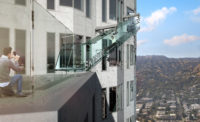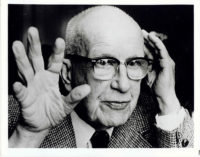Known for its investigations in building with wood, Vancouver-based Michael Green Architecture (MGA) has announced plans to break ground in May on what will be North America’s tallest wood structure.
The Wood Innovation and Design Centre (WIDC) in Prince George, British Columbia, Canada, is a roughly $24.5 million (U.S.), 90-foot-tall building that showcases the latest in wood construction. Owned by the city, it will also be the home to the University of Northern British Columbia’s new masters of engineering program in tall wood design. Though only six stories, architect Michael Green says the height of the design center will be equivalent to a nine-story residential building because of a high floor-to-floor ratio, a mezzanine level, and a penthouse for mechanical systems.
In the main lobby, a planned demonstration space would incorporate wood slats that allow people to see, smell, and touch different types of wood. Large windows open to the street. The mezzanine holds a 75-seat distance learning theater that enables students to share their work by videoconference. Above it are classrooms, lounge spaces, and a roof deck. The higher floors contain offices for as-yet undetermined tenants.
The architects received special dispensation to build up to six stories (current country codes limit wood buildings to four stories). Set to open for the new school term September 2014, Green hopes the structure will be the first of many. The architect has been on somewhat of a wood construction crusade in the last year or so, sharing his ideas at conferences such as the annual TED Conference in February and in a March 2012 white paper called “The Case for Tall Wood Buildings.” While his renderings of 30-story wood towers use steel beams for part of the frame, the WIDC is all wood except for the metal joinery. MGA developed this system with engineering company Equilibrium Consulting. The WIDC will be constructed with local woods such as Douglas fir, spruce, hemlock, and Western Red Cedar in a nod to the local forestry industry. “What has allowed us to move to this new kind of building is the use of mass timber panels,” says Green. “These materials come in huge sheet sizes that are thick enough that they have an inherent fire resistance.”
Though WIDC’s foundation is concrete and there are metal connections between the wood slabs, the building’s columns, beams, and floor will be made of wood. So will the elevator and stair core that form the structure’s lateral bracing. “Traditionally that would be made with steel or concrete,” says Green, “Now we’ve been able to show that even the elevator shaft can be made with these mass timber panels.” According to the architect, studies have shown the same method could be employed to construct buildings up to 20 stories tall. More wood construction would not only bolster local economy, Green says it is more sustainable. “One cubic meter of wood sequesters 1 to 1.6 tons of carbon dioxide, storing carbon dioxide in a building rather than emitting carbon dioxide,” he says. He advocates using wood harvested responsibly through certified forestry practices.
“We would love to see British Columbia pioneer the techniques and technologies required to produce mass timber buildings in other countries like China, where the need for multifamily housing is growing at an alarming rate, along with the consequent environmental impacts,” says Carla Smith, an associate architect at MGA. “By promoting the use of wood construction in areas poised to build a staggering number of buildings over the next 50 years, we can make a dramatic impact on carbon footprints on a national and global scale.”






Post a comment to this article
Report Abusive Comment